Corporate Accounting Analysis: Folkestone Education Trust Report
VerifiedAdded on 2020/05/28
|8
|1576
|51
Report
AI Summary
This report provides a detailed analysis of the corporate accounting practices of Folkestone Education Trust. It examines various components of equity, including contributed equity, undistributed profits, and available-for-sale financial assets reserve, highlighting the changes in these values between 2016 and 2017. The report further investigates the tax expenses incurred by the company, comparing the tax expense for 2017 and 2016 and analyzes the effective tax rate. It also explores the deferred tax assets and liabilities, noting the absence of deferred tax assets and the presence of deferred tax liabilities. Additionally, the report compares current tax assets and distribution tax payable, highlighting the differences between income tax expense and distribution payable. The analysis also provides insights into the treatment of tax in the financial statements, mentioning the complexities and the lack of detailed information. The report concludes by discussing the use of tax rates in capital budgeting decisions and the overall insights gained from the financial statement analysis, including the use of a flow-through basis for taxation and the determination of present value using a discount rate.
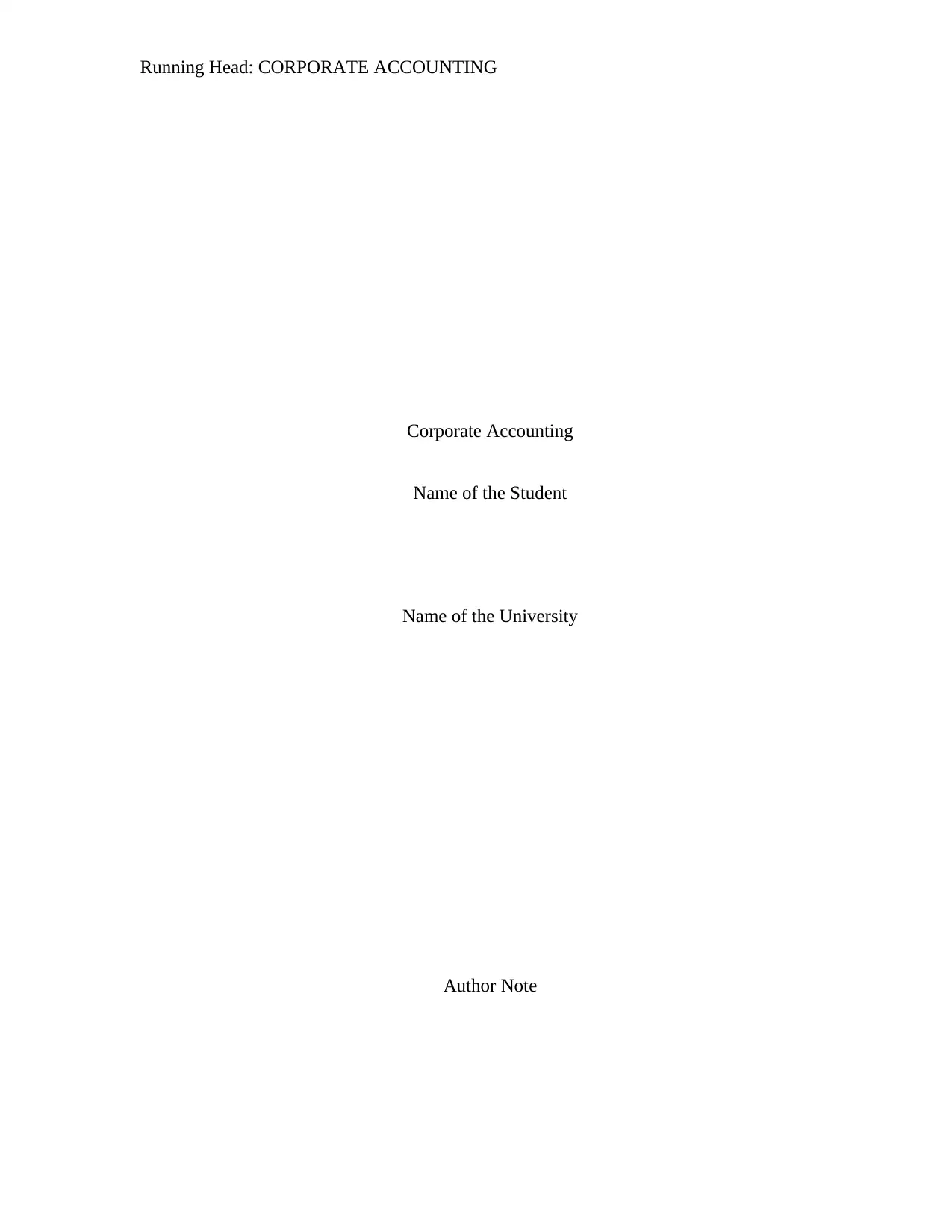
Running Head: CORPORATE ACCOUNTING
Corporate Accounting
Name of the Student
Name of the University
Author Note
Corporate Accounting
Name of the Student
Name of the University
Author Note
Paraphrase This Document
Need a fresh take? Get an instant paraphrase of this document with our AI Paraphraser
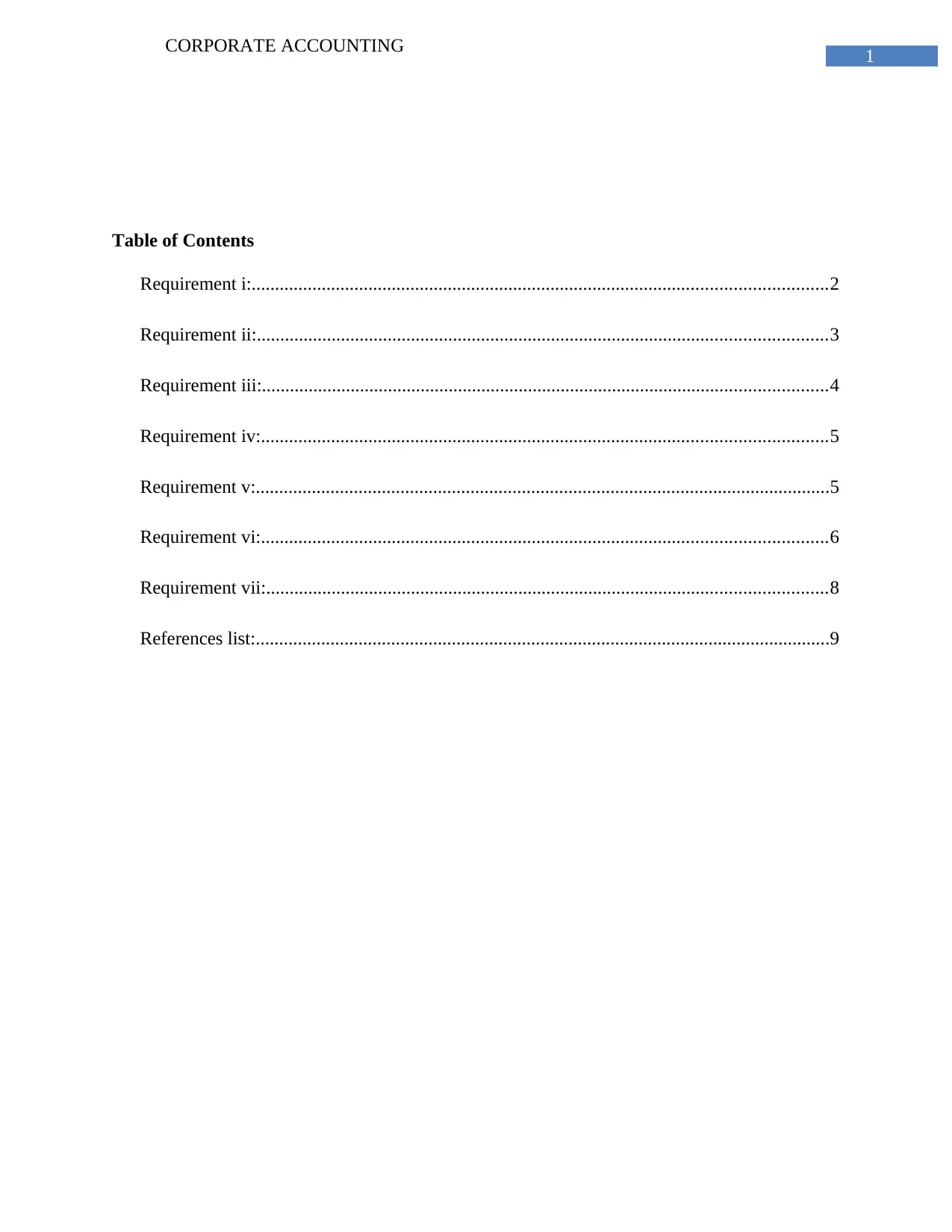
1
CORPORATE ACCOUNTING
Table of Contents
Requirement i:...........................................................................................................................2
Requirement ii:..........................................................................................................................3
Requirement iii:.........................................................................................................................4
Requirement iv:.........................................................................................................................5
Requirement v:...........................................................................................................................5
Requirement vi:.........................................................................................................................6
Requirement vii:........................................................................................................................8
References list:...........................................................................................................................9
CORPORATE ACCOUNTING
Table of Contents
Requirement i:...........................................................................................................................2
Requirement ii:..........................................................................................................................3
Requirement iii:.........................................................................................................................4
Requirement iv:.........................................................................................................................5
Requirement v:...........................................................................................................................5
Requirement vi:.........................................................................................................................6
Requirement vii:........................................................................................................................8
References list:...........................................................................................................................9
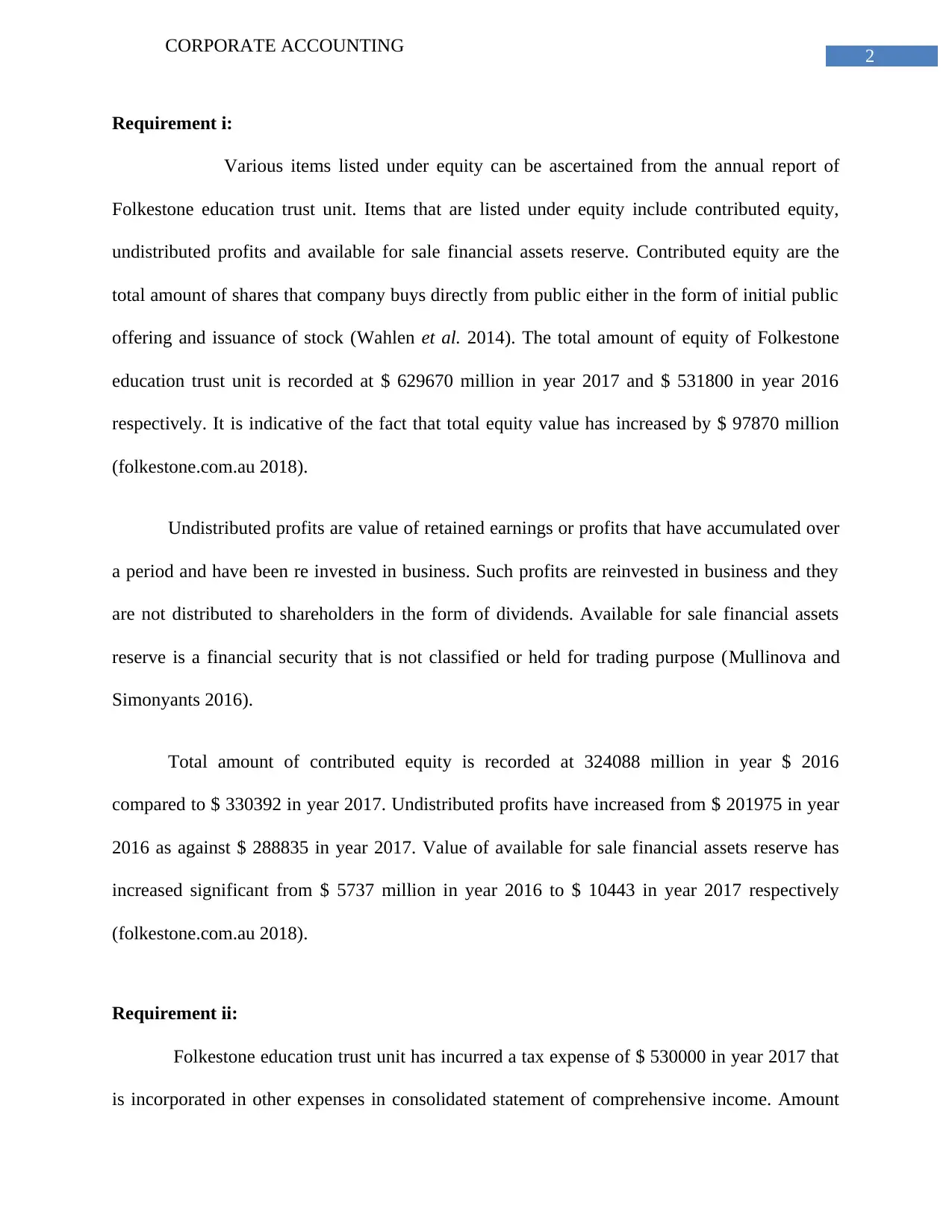
2
CORPORATE ACCOUNTING
Requirement i:
Various items listed under equity can be ascertained from the annual report of
Folkestone education trust unit. Items that are listed under equity include contributed equity,
undistributed profits and available for sale financial assets reserve. Contributed equity are the
total amount of shares that company buys directly from public either in the form of initial public
offering and issuance of stock (Wahlen et al. 2014). The total amount of equity of Folkestone
education trust unit is recorded at $ 629670 million in year 2017 and $ 531800 in year 2016
respectively. It is indicative of the fact that total equity value has increased by $ 97870 million
(folkestone.com.au 2018).
Undistributed profits are value of retained earnings or profits that have accumulated over
a period and have been re invested in business. Such profits are reinvested in business and they
are not distributed to shareholders in the form of dividends. Available for sale financial assets
reserve is a financial security that is not classified or held for trading purpose (Mullinova and
Simonyants 2016).
Total amount of contributed equity is recorded at 324088 million in year $ 2016
compared to $ 330392 in year 2017. Undistributed profits have increased from $ 201975 in year
2016 as against $ 288835 in year 2017. Value of available for sale financial assets reserve has
increased significant from $ 5737 million in year 2016 to $ 10443 in year 2017 respectively
(folkestone.com.au 2018).
Requirement ii:
Folkestone education trust unit has incurred a tax expense of $ 530000 in year 2017 that
is incorporated in other expenses in consolidated statement of comprehensive income. Amount
CORPORATE ACCOUNTING
Requirement i:
Various items listed under equity can be ascertained from the annual report of
Folkestone education trust unit. Items that are listed under equity include contributed equity,
undistributed profits and available for sale financial assets reserve. Contributed equity are the
total amount of shares that company buys directly from public either in the form of initial public
offering and issuance of stock (Wahlen et al. 2014). The total amount of equity of Folkestone
education trust unit is recorded at $ 629670 million in year 2017 and $ 531800 in year 2016
respectively. It is indicative of the fact that total equity value has increased by $ 97870 million
(folkestone.com.au 2018).
Undistributed profits are value of retained earnings or profits that have accumulated over
a period and have been re invested in business. Such profits are reinvested in business and they
are not distributed to shareholders in the form of dividends. Available for sale financial assets
reserve is a financial security that is not classified or held for trading purpose (Mullinova and
Simonyants 2016).
Total amount of contributed equity is recorded at 324088 million in year $ 2016
compared to $ 330392 in year 2017. Undistributed profits have increased from $ 201975 in year
2016 as against $ 288835 in year 2017. Value of available for sale financial assets reserve has
increased significant from $ 5737 million in year 2016 to $ 10443 in year 2017 respectively
(folkestone.com.au 2018).
Requirement ii:
Folkestone education trust unit has incurred a tax expense of $ 530000 in year 2017 that
is incorporated in other expenses in consolidated statement of comprehensive income. Amount
⊘ This is a preview!⊘
Do you want full access?
Subscribe today to unlock all pages.

Trusted by 1+ million students worldwide
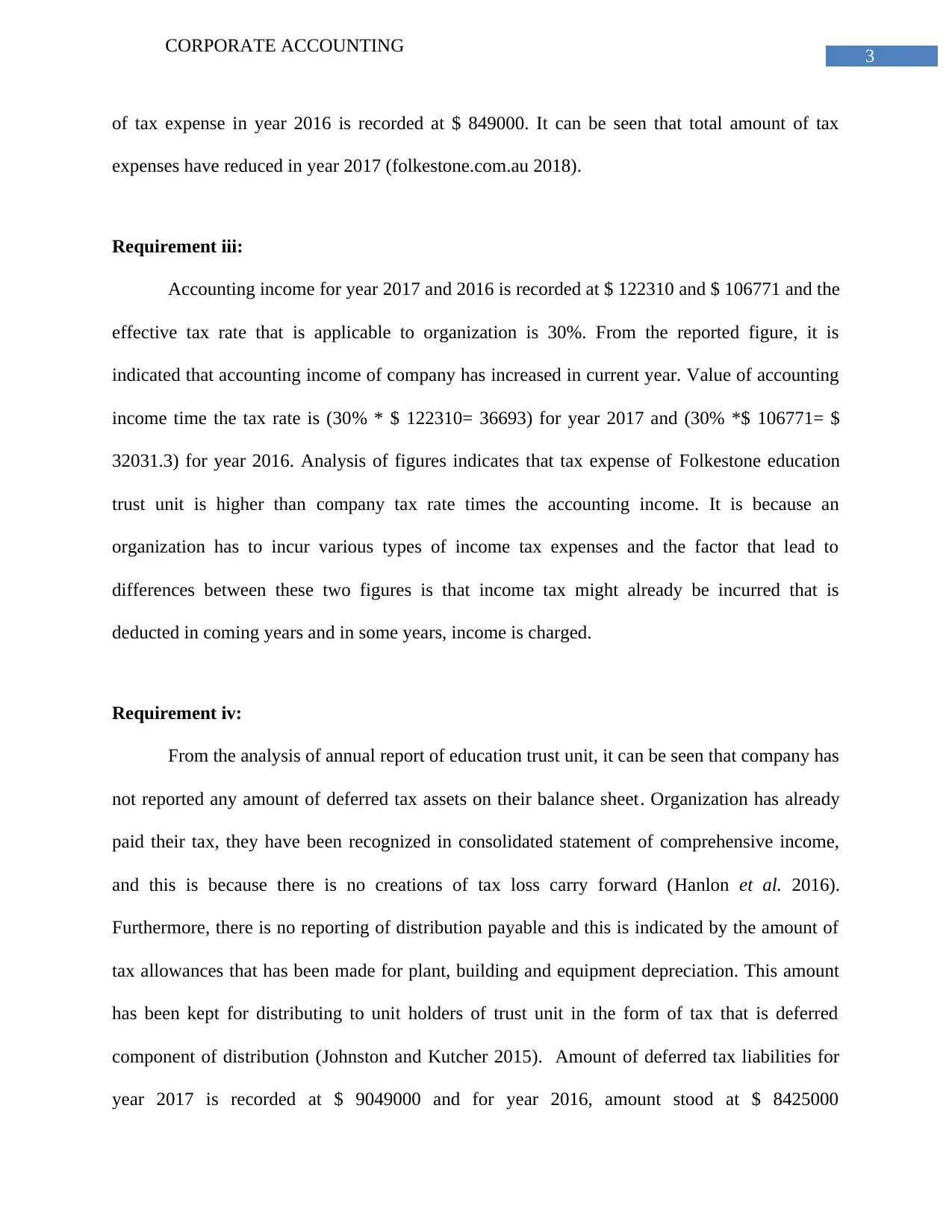
3
CORPORATE ACCOUNTING
of tax expense in year 2016 is recorded at $ 849000. It can be seen that total amount of tax
expenses have reduced in year 2017 (folkestone.com.au 2018).
Requirement iii:
Accounting income for year 2017 and 2016 is recorded at $ 122310 and $ 106771 and the
effective tax rate that is applicable to organization is 30%. From the reported figure, it is
indicated that accounting income of company has increased in current year. Value of accounting
income time the tax rate is (30% * $ 122310= 36693) for year 2017 and (30% *$ 106771= $
32031.3) for year 2016. Analysis of figures indicates that tax expense of Folkestone education
trust unit is higher than company tax rate times the accounting income. It is because an
organization has to incur various types of income tax expenses and the factor that lead to
differences between these two figures is that income tax might already be incurred that is
deducted in coming years and in some years, income is charged.
Requirement iv:
From the analysis of annual report of education trust unit, it can be seen that company has
not reported any amount of deferred tax assets on their balance sheet. Organization has already
paid their tax, they have been recognized in consolidated statement of comprehensive income,
and this is because there is no creations of tax loss carry forward (Hanlon et al. 2016).
Furthermore, there is no reporting of distribution payable and this is indicated by the amount of
tax allowances that has been made for plant, building and equipment depreciation. This amount
has been kept for distributing to unit holders of trust unit in the form of tax that is deferred
component of distribution (Johnston and Kutcher 2015). Amount of deferred tax liabilities for
year 2017 is recorded at $ 9049000 and for year 2016, amount stood at $ 8425000
CORPORATE ACCOUNTING
of tax expense in year 2016 is recorded at $ 849000. It can be seen that total amount of tax
expenses have reduced in year 2017 (folkestone.com.au 2018).
Requirement iii:
Accounting income for year 2017 and 2016 is recorded at $ 122310 and $ 106771 and the
effective tax rate that is applicable to organization is 30%. From the reported figure, it is
indicated that accounting income of company has increased in current year. Value of accounting
income time the tax rate is (30% * $ 122310= 36693) for year 2017 and (30% *$ 106771= $
32031.3) for year 2016. Analysis of figures indicates that tax expense of Folkestone education
trust unit is higher than company tax rate times the accounting income. It is because an
organization has to incur various types of income tax expenses and the factor that lead to
differences between these two figures is that income tax might already be incurred that is
deducted in coming years and in some years, income is charged.
Requirement iv:
From the analysis of annual report of education trust unit, it can be seen that company has
not reported any amount of deferred tax assets on their balance sheet. Organization has already
paid their tax, they have been recognized in consolidated statement of comprehensive income,
and this is because there is no creations of tax loss carry forward (Hanlon et al. 2016).
Furthermore, there is no reporting of distribution payable and this is indicated by the amount of
tax allowances that has been made for plant, building and equipment depreciation. This amount
has been kept for distributing to unit holders of trust unit in the form of tax that is deferred
component of distribution (Johnston and Kutcher 2015). Amount of deferred tax liabilities for
year 2017 is recorded at $ 9049000 and for year 2016, amount stood at $ 8425000
Paraphrase This Document
Need a fresh take? Get an instant paraphrase of this document with our AI Paraphraser
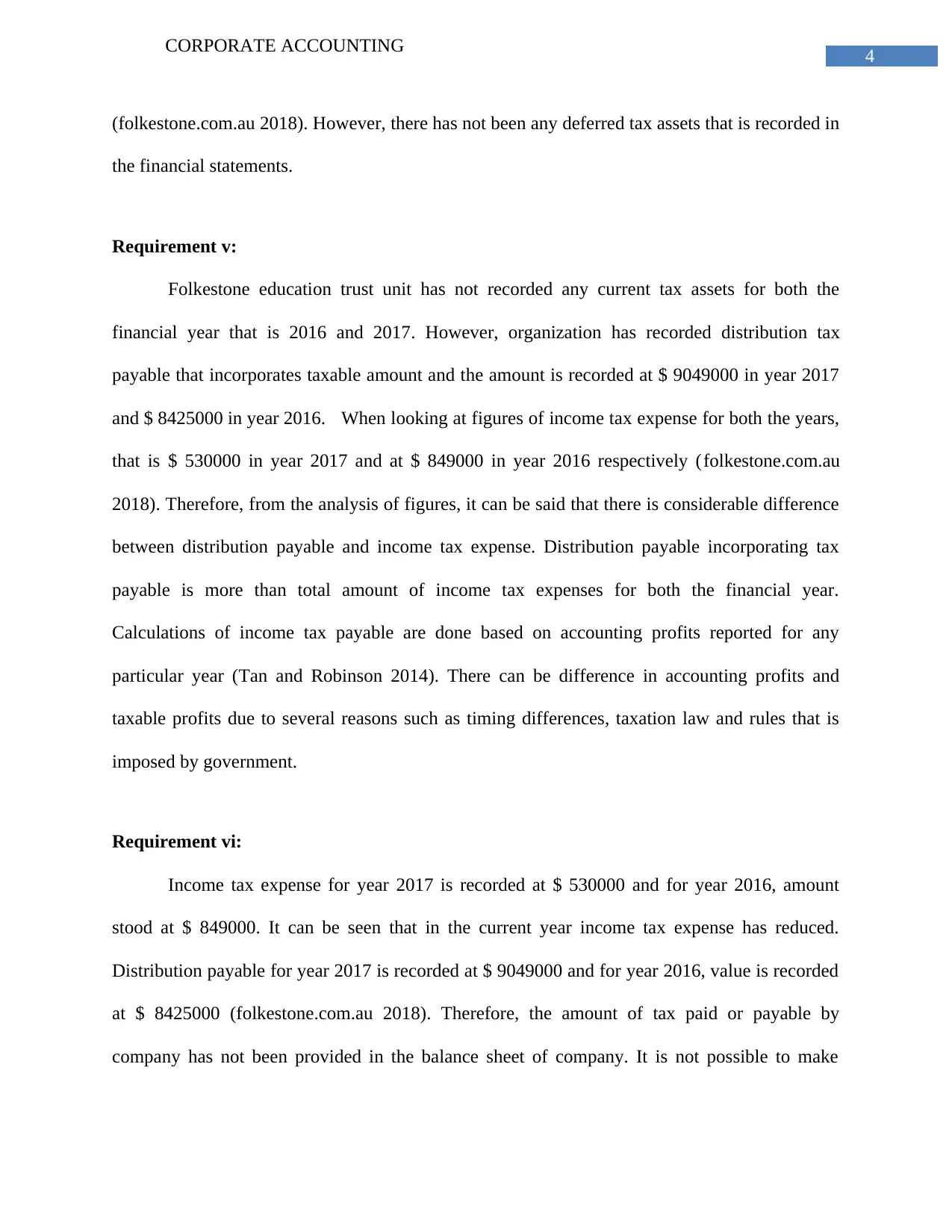
4
CORPORATE ACCOUNTING
(folkestone.com.au 2018). However, there has not been any deferred tax assets that is recorded in
the financial statements.
Requirement v:
Folkestone education trust unit has not recorded any current tax assets for both the
financial year that is 2016 and 2017. However, organization has recorded distribution tax
payable that incorporates taxable amount and the amount is recorded at $ 9049000 in year 2017
and $ 8425000 in year 2016. When looking at figures of income tax expense for both the years,
that is $ 530000 in year 2017 and at $ 849000 in year 2016 respectively (folkestone.com.au
2018). Therefore, from the analysis of figures, it can be said that there is considerable difference
between distribution payable and income tax expense. Distribution payable incorporating tax
payable is more than total amount of income tax expenses for both the financial year.
Calculations of income tax payable are done based on accounting profits reported for any
particular year (Tan and Robinson 2014). There can be difference in accounting profits and
taxable profits due to several reasons such as timing differences, taxation law and rules that is
imposed by government.
Requirement vi:
Income tax expense for year 2017 is recorded at $ 530000 and for year 2016, amount
stood at $ 849000. It can be seen that in the current year income tax expense has reduced.
Distribution payable for year 2017 is recorded at $ 9049000 and for year 2016, value is recorded
at $ 8425000 (folkestone.com.au 2018). Therefore, the amount of tax paid or payable by
company has not been provided in the balance sheet of company. It is not possible to make
CORPORATE ACCOUNTING
(folkestone.com.au 2018). However, there has not been any deferred tax assets that is recorded in
the financial statements.
Requirement v:
Folkestone education trust unit has not recorded any current tax assets for both the
financial year that is 2016 and 2017. However, organization has recorded distribution tax
payable that incorporates taxable amount and the amount is recorded at $ 9049000 in year 2017
and $ 8425000 in year 2016. When looking at figures of income tax expense for both the years,
that is $ 530000 in year 2017 and at $ 849000 in year 2016 respectively (folkestone.com.au
2018). Therefore, from the analysis of figures, it can be said that there is considerable difference
between distribution payable and income tax expense. Distribution payable incorporating tax
payable is more than total amount of income tax expenses for both the financial year.
Calculations of income tax payable are done based on accounting profits reported for any
particular year (Tan and Robinson 2014). There can be difference in accounting profits and
taxable profits due to several reasons such as timing differences, taxation law and rules that is
imposed by government.
Requirement vi:
Income tax expense for year 2017 is recorded at $ 530000 and for year 2016, amount
stood at $ 849000. It can be seen that in the current year income tax expense has reduced.
Distribution payable for year 2017 is recorded at $ 9049000 and for year 2016, value is recorded
at $ 8425000 (folkestone.com.au 2018). Therefore, the amount of tax paid or payable by
company has not been provided in the balance sheet of company. It is not possible to make
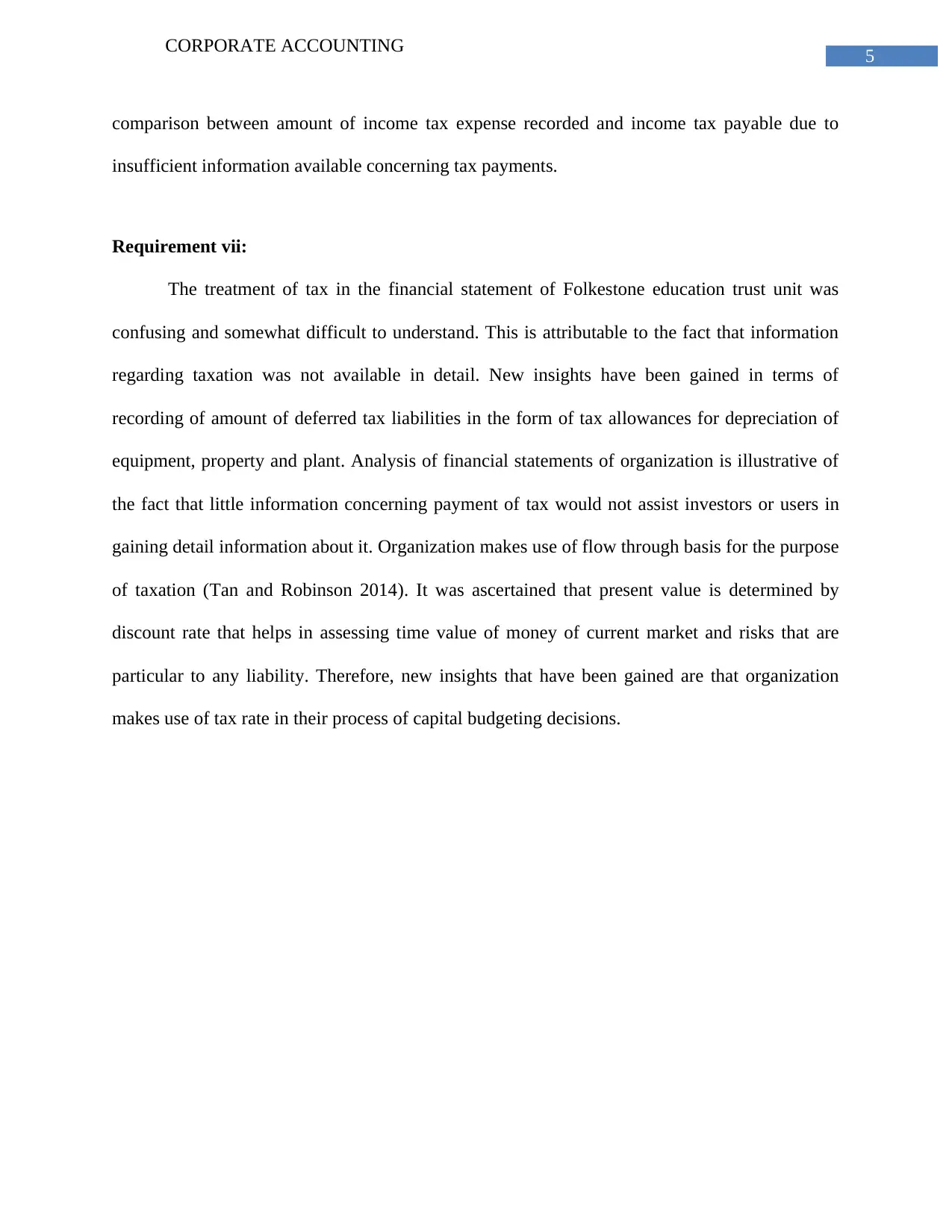
5
CORPORATE ACCOUNTING
comparison between amount of income tax expense recorded and income tax payable due to
insufficient information available concerning tax payments.
Requirement vii:
The treatment of tax in the financial statement of Folkestone education trust unit was
confusing and somewhat difficult to understand. This is attributable to the fact that information
regarding taxation was not available in detail. New insights have been gained in terms of
recording of amount of deferred tax liabilities in the form of tax allowances for depreciation of
equipment, property and plant. Analysis of financial statements of organization is illustrative of
the fact that little information concerning payment of tax would not assist investors or users in
gaining detail information about it. Organization makes use of flow through basis for the purpose
of taxation (Tan and Robinson 2014). It was ascertained that present value is determined by
discount rate that helps in assessing time value of money of current market and risks that are
particular to any liability. Therefore, new insights that have been gained are that organization
makes use of tax rate in their process of capital budgeting decisions.
CORPORATE ACCOUNTING
comparison between amount of income tax expense recorded and income tax payable due to
insufficient information available concerning tax payments.
Requirement vii:
The treatment of tax in the financial statement of Folkestone education trust unit was
confusing and somewhat difficult to understand. This is attributable to the fact that information
regarding taxation was not available in detail. New insights have been gained in terms of
recording of amount of deferred tax liabilities in the form of tax allowances for depreciation of
equipment, property and plant. Analysis of financial statements of organization is illustrative of
the fact that little information concerning payment of tax would not assist investors or users in
gaining detail information about it. Organization makes use of flow through basis for the purpose
of taxation (Tan and Robinson 2014). It was ascertained that present value is determined by
discount rate that helps in assessing time value of money of current market and risks that are
particular to any liability. Therefore, new insights that have been gained are that organization
makes use of tax rate in their process of capital budgeting decisions.
⊘ This is a preview!⊘
Do you want full access?
Subscribe today to unlock all pages.

Trusted by 1+ million students worldwide
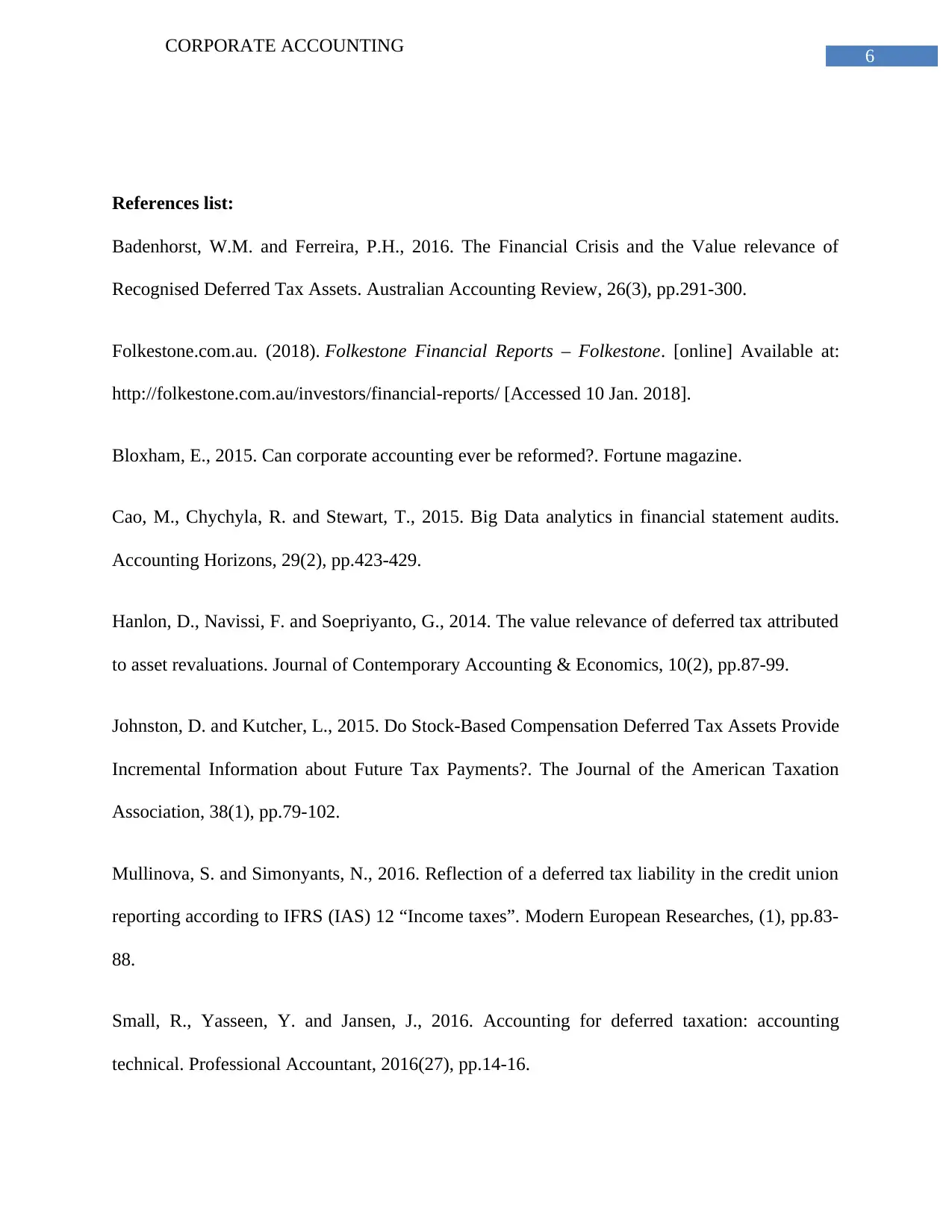
6
CORPORATE ACCOUNTING
References list:
Badenhorst, W.M. and Ferreira, P.H., 2016. The Financial Crisis and the Value relevance of
Recognised Deferred Tax Assets. Australian Accounting Review, 26(3), pp.291-300.
Folkestone.com.au. (2018). Folkestone Financial Reports – Folkestone. [online] Available at:
http://folkestone.com.au/investors/financial-reports/ [Accessed 10 Jan. 2018].
Bloxham, E., 2015. Can corporate accounting ever be reformed?. Fortune magazine.
Cao, M., Chychyla, R. and Stewart, T., 2015. Big Data analytics in financial statement audits.
Accounting Horizons, 29(2), pp.423-429.
Hanlon, D., Navissi, F. and Soepriyanto, G., 2014. The value relevance of deferred tax attributed
to asset revaluations. Journal of Contemporary Accounting & Economics, 10(2), pp.87-99.
Johnston, D. and Kutcher, L., 2015. Do Stock-Based Compensation Deferred Tax Assets Provide
Incremental Information about Future Tax Payments?. The Journal of the American Taxation
Association, 38(1), pp.79-102.
Mullinova, S. and Simonyants, N., 2016. Reflection of a deferred tax liability in the credit union
reporting according to IFRS (IAS) 12 “Income taxes”. Modern European Researches, (1), pp.83-
88.
Small, R., Yasseen, Y. and Jansen, J., 2016. Accounting for deferred taxation: accounting
technical. Professional Accountant, 2016(27), pp.14-16.
CORPORATE ACCOUNTING
References list:
Badenhorst, W.M. and Ferreira, P.H., 2016. The Financial Crisis and the Value relevance of
Recognised Deferred Tax Assets. Australian Accounting Review, 26(3), pp.291-300.
Folkestone.com.au. (2018). Folkestone Financial Reports – Folkestone. [online] Available at:
http://folkestone.com.au/investors/financial-reports/ [Accessed 10 Jan. 2018].
Bloxham, E., 2015. Can corporate accounting ever be reformed?. Fortune magazine.
Cao, M., Chychyla, R. and Stewart, T., 2015. Big Data analytics in financial statement audits.
Accounting Horizons, 29(2), pp.423-429.
Hanlon, D., Navissi, F. and Soepriyanto, G., 2014. The value relevance of deferred tax attributed
to asset revaluations. Journal of Contemporary Accounting & Economics, 10(2), pp.87-99.
Johnston, D. and Kutcher, L., 2015. Do Stock-Based Compensation Deferred Tax Assets Provide
Incremental Information about Future Tax Payments?. The Journal of the American Taxation
Association, 38(1), pp.79-102.
Mullinova, S. and Simonyants, N., 2016. Reflection of a deferred tax liability in the credit union
reporting according to IFRS (IAS) 12 “Income taxes”. Modern European Researches, (1), pp.83-
88.
Small, R., Yasseen, Y. and Jansen, J., 2016. Accounting for deferred taxation: accounting
technical. Professional Accountant, 2016(27), pp.14-16.
Paraphrase This Document
Need a fresh take? Get an instant paraphrase of this document with our AI Paraphraser
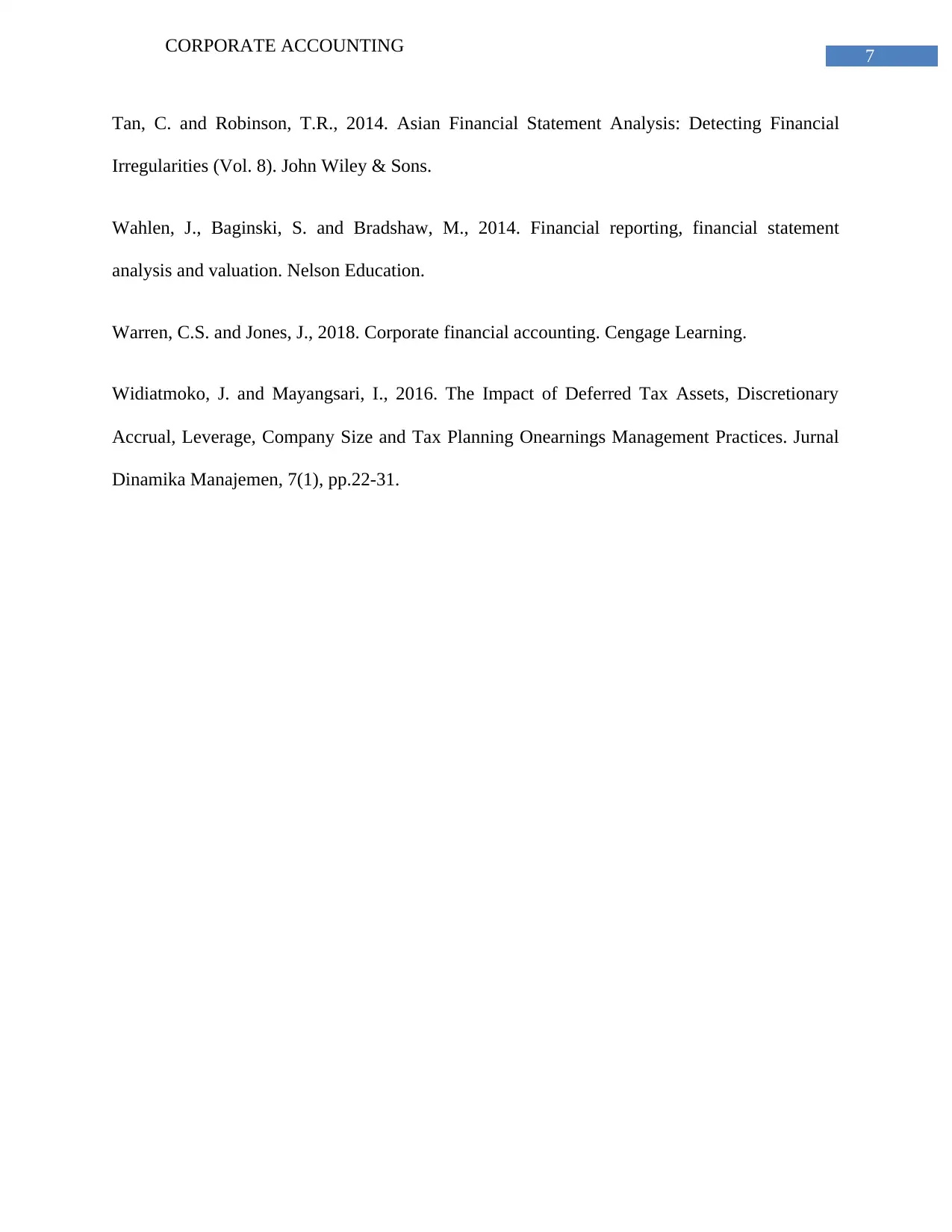
7
CORPORATE ACCOUNTING
Tan, C. and Robinson, T.R., 2014. Asian Financial Statement Analysis: Detecting Financial
Irregularities (Vol. 8). John Wiley & Sons.
Wahlen, J., Baginski, S. and Bradshaw, M., 2014. Financial reporting, financial statement
analysis and valuation. Nelson Education.
Warren, C.S. and Jones, J., 2018. Corporate financial accounting. Cengage Learning.
Widiatmoko, J. and Mayangsari, I., 2016. The Impact of Deferred Tax Assets, Discretionary
Accrual, Leverage, Company Size and Tax Planning Onearnings Management Practices. Jurnal
Dinamika Manajemen, 7(1), pp.22-31.
CORPORATE ACCOUNTING
Tan, C. and Robinson, T.R., 2014. Asian Financial Statement Analysis: Detecting Financial
Irregularities (Vol. 8). John Wiley & Sons.
Wahlen, J., Baginski, S. and Bradshaw, M., 2014. Financial reporting, financial statement
analysis and valuation. Nelson Education.
Warren, C.S. and Jones, J., 2018. Corporate financial accounting. Cengage Learning.
Widiatmoko, J. and Mayangsari, I., 2016. The Impact of Deferred Tax Assets, Discretionary
Accrual, Leverage, Company Size and Tax Planning Onearnings Management Practices. Jurnal
Dinamika Manajemen, 7(1), pp.22-31.
1 out of 8
Related Documents
Your All-in-One AI-Powered Toolkit for Academic Success.
+13062052269
info@desklib.com
Available 24*7 on WhatsApp / Email
![[object Object]](/_next/static/media/star-bottom.7253800d.svg)
Unlock your academic potential
Copyright © 2020–2025 A2Z Services. All Rights Reserved. Developed and managed by ZUCOL.





